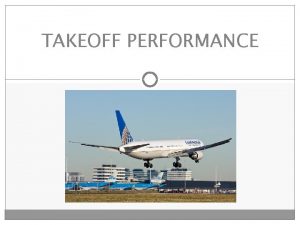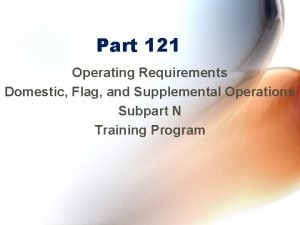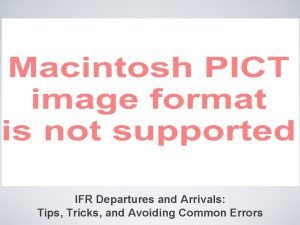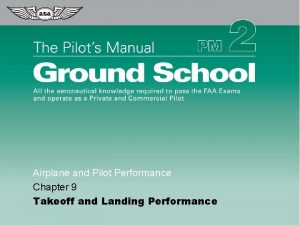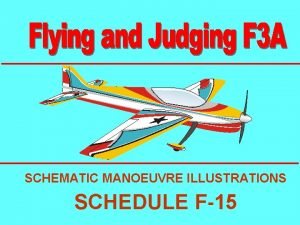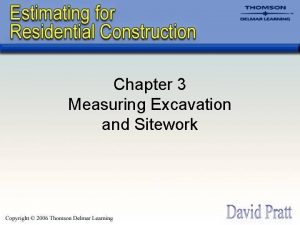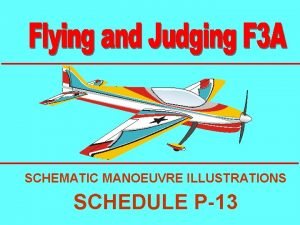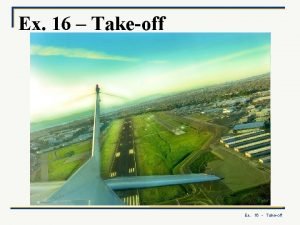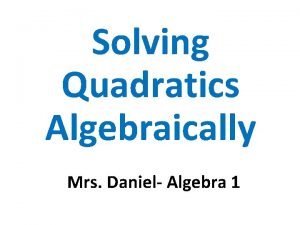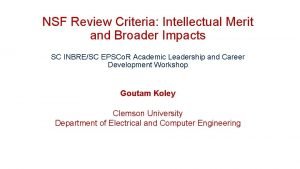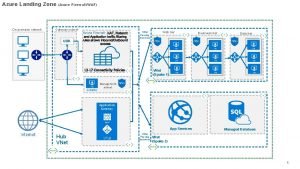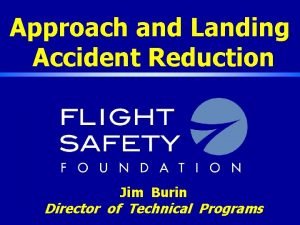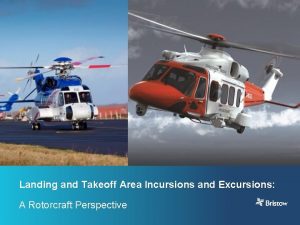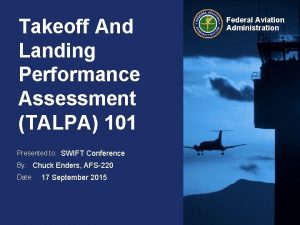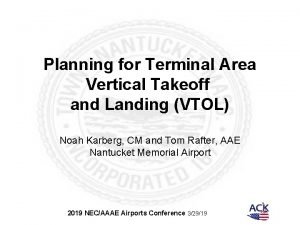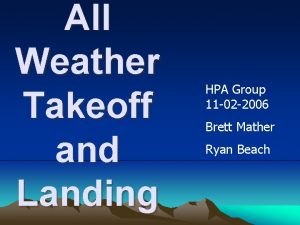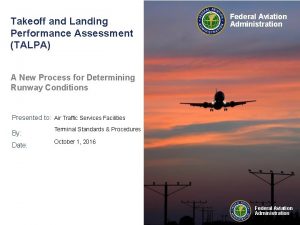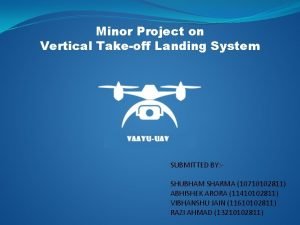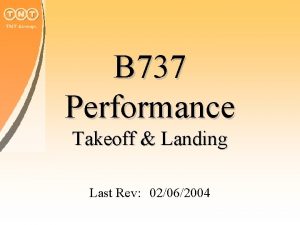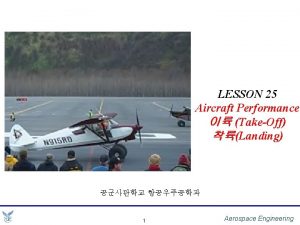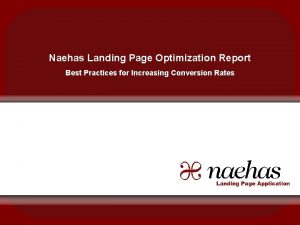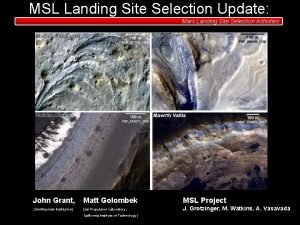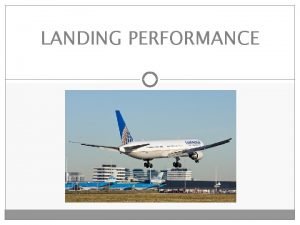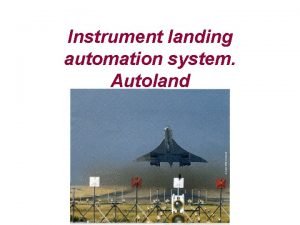Modeled Trends in Impacts of Landing and Takeoff






















- Slides: 22

Modeled Trends in Impacts of Landing and Takeoff Aircraft Emissions on Surface Air-Quality in U. S for 2005, 2010 and 2018 Lakshmi Pradeepa Vennam 1, Saravanan Arunachalam 1, Jared Bowden 1, B. H Baek 1, Mohammad Omary 1, William Vizuete 1, Seth Olsen 2 1 University 2 formerly of North Carolina, Chapel Hill, NC @ University of Illinois at Urbana-Champaign, IL

Background and Motivation • Aircraft emits CO, NOx, SO 2, VOCs and Particulate Matter; aviation NOx can contribute about ~0. 5% to overall US anthropogenic NOx and 5 -7% in some counties (Fulton county, Atlanta) • Landing and Takeoff (LTO) emissions comprise of emissions from idle, taxi, take-off, climbout and landing activity phases. ~150 airports exists in non-attainment area in US (Ratliff et al. , FAA-PARTNER report, 2009). • LTO emissions from large airports can have 28 -35% of PM 2. 5 impacts occurring 300 km away from the airports due to the secondary aerosol formation (Arunachalam et al. , AE, 2011). • Aviation-attributable health impacts due to PM 2. 5 will be ~6 x in 2025 compared to 2005 (Woody et al. , AE, 2011; Levy et al, 2012). • Limited studies considered all US airports LTO emissions to study their impacts and prior studies stressed the need to study LTO impacts both in terms of health risks and policy. 2

Objective • FAA’s Aspirational Goal: Achieve an absolute reduction in aviation emissions induced “significant health impacts” • Develop comprehensive modeling framework to assess year-overyear AQ and health impacts of aviation emissions – On National basis (This presentation) and – Airport-by-Airport basis (See Boone et al, CMAS 2014 Poster) • Understand how the background emissions (non-aviation) change the aviation impacts on surface AQ 3

Methodology 4

Emission Analysis • NEI Emissions • AEDT aircraft Emissions • Lightning Emissions

Emission comparison Aircraft emissions domain totals for annual years Both background aircraft emissions decreased from 2005 to 2010, but the contribution of aviation to total emissions is still higher in 2010. 6

Lightning Emissions Lightning emissions show strong seasonal trend and very high particularly during summer months. 7

CMAQ US-wide modeling • Model Evaluation (Surface & in-situ aircraft observations) • Aviation Impacts

Model Evaluation (Surface Observations) 2005 2010 O 3 PM 2. 5 For both 2005 and 2010, O 3 normalized mean bias (NMB) -20 to +60 % (similar model performance). For PM 2. 5, model underpredicts in 2005 and overpredicts in 2010 (differences in inorganic aerosols). 9

Model Evaluation (Surface Observations) 2005 2010 Gas Aerosol Between 2005 and 2010, overall similar model performance in case of gas species but differences exist in aerosol species. 10

Aircraft observations (MOZAIC) New York airport Chicago airport Vertical profile of model predictions are comparable with observations near airports. 11

Aviation contributions in 2005 Annual aviation percent contributions O 3 NO 2 PM 2. 5 Observing decreases in O 3 near urban areas, annual US aviation perturbation is ~0. 02% (max: 0. 08%) For NO 2 and PM 2. 5, the US aviation perturbation is ~0. 25% and ~0. 035% (max: 3. 72% and 0. 26%). 12

Aviation contributions in 2010 Annual aviation percent contributions O 3 NO 2 PM 2. 5 Spatially aviation contributions in 2010 appear similar to 2005, annual US averages are O 3: ~0. 025% (max: 0. 08%), NO 2: ~0. 28% (max: 4. 65%), PM 2. 5: ~0. 037% (max: 0. 25%) 13

Ozone 8 hr Summer months (May-Sep) aviation percent contributions 2005 2010 Summer months 8 hr. max O 3 shows 0. 3% and 0. 6% maximum increase due to aviation in 2005 and 2010 respectively. 14

Differences between 2010 and 2005 aviation contributions O 3 NO 2 PM 2. 5 2010 shows slight increase in NO 2 (max: 0. 02 ppbv) and PM 2. 5 (max: 7. 6 ng/m 3) concentrations near airports. 15

PRESENT and FUTURE TRENDS FUTURE WORK: • We will apply similar modeling framework for future year (i. e. , 2018) and study contributions from projected future year aviation emissions. • Explore emission reduction strategies and policy options to achieve FAA’s aspirational goal. 16

CONCLUSIONS • Developed enhanced modeling framework to study aviation contributions of LTO emissions from all US airports. • Evaluated model predictions with both surface and in-situ aircraft observations. • Observed decreases in O 3 near airports, annual US aviation perturbation is ~0. 02 -0. 025% in 2005 and 2010 (but maximum can be ~0. 08%). • In case of NO 2 and PM 2. 5, the US aviation contribution is ~0. 02% (max ~3. 54. 5%) and ~0. 035% (max ~0. 25%) in 2005 and 2010. • Spatially, aviation contribution looks similar between 2005 and 2010, but observed slight increases near bigger airports in 2010. 17

ACKNOWLEDGEMENTS Funding: Federal Aviation Administration (FAA) • Advisors : Sarav Arunachalam, Will Vizuete & Committee Members (Rohit Mathur, Marc Serre, Jason West) • UNC – Institute for Environment, Labmates (Matt, Changsy, Scott) THANK YOU 18

EXTRA SLIDES

20

21

Major Improvements and tools • AEDT based aircraft emissions on a chorded flight-segment basis (LTO only) – Developed AEDTProc tool for CMAQ • MERRA to WRF meteorology downscaling tool • CAMChem to CMAQ boundary conditions downscaling tool - Species mapping - Horizontal interpolation - Vertical interpolation • NLDN based lightning emissions - NLDN flash density observation data - Vertical allocation based on meteorology layers • Online Photolysis - Calculates photolysis rates incorporating radiative impacts of aerosol loading 22
 Gross takeoff weight
Gross takeoff weight Part 121 alternate requirements
Part 121 alternate requirements Phlbo
Phlbo Takeoff flaps
Takeoff flaps F15 takeoff
F15 takeoff Excavation takeoff
Excavation takeoff Pull-push takeoff
Pull-push takeoff Opencore takeoff delay
Opencore takeoff delay Cnaf 3710
Cnaf 3710 Takeoff ex
Takeoff ex Daniel kicks a soccer ball and the trajectory is modeled by
Daniel kicks a soccer ball and the trajectory is modeled by Which sum or difference is modeled by the algebra tiles
Which sum or difference is modeled by the algebra tiles Elizabethan tragedies were modeled on plays from
Elizabethan tragedies were modeled on plays from 1-1 homework points lines and planes
1-1 homework points lines and planes Quadratic graph
Quadratic graph Hughes modeled his stanza forms on
Hughes modeled his stanza forms on Positive impacts of materials technology
Positive impacts of materials technology Positive impacts of materials technology
Positive impacts of materials technology Positive and negative impacts of materials technology
Positive and negative impacts of materials technology Nsf grfp results
Nsf grfp results Landing zone azure
Landing zone azure Approach and landing accident reduction
Approach and landing accident reduction Negative effects of technology on environment
Negative effects of technology on environment
